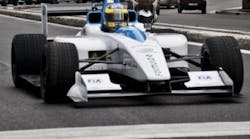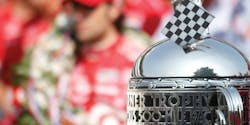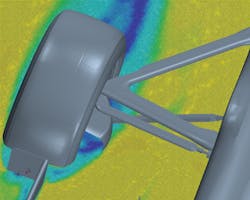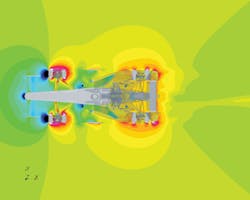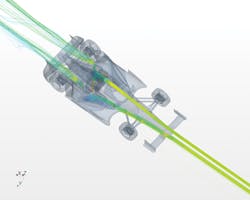One of the major changes computers have injected into the Indianapolis 500 over the past two decades is the widespread use of simulation. No longer do designers or race teams have to schedule racetrack time to determine the effects of a small tweak to the aerodynamics or front shock absorbers, a costly and time-consuming process. Instead, they can juggle a few parameters in a detailed computer model of the car and then run it over a truly realistic model of a specific racetrack. The program spits out detailed and reliable results on speeds, fuel consumption, downforce, and a laundry list of other race-car characteristics. It can also compress hours of track time into a few minutes of computer run time.
Simulation has also spread so that the three groups most closely involved in Indy racing — the designers, race teams, and governing body — all rely on it, but in different ways.
Indy-car designers
IndyCar races currently allow only one chassis or car, the DW12 from Dallara Automobili, Varano Melegari, Italy. “We use three general types of simulation when designing an Indy car,” says Dallara’s general manager, Andrea Pontremoli. “It lets us go from the design phase to the racetrack in about nine months — eight months spent designing the car on computers, then a month to actually assemble it.”
The first type of simulation lets Dallara engineers build a virtual car using carbon composites. “We use finite-element-method software at this stage to simulate the carbon-fiber components and structural elements,” says Pontremoli. They subsequently add other parts to model the entire car, minus the engine.
“To get the overall shape of the car and its aerodynamics right, we then use computational fluid-dynamics (CFD) software to simulate airflow over, under, and around the car,” says Pontremoli.
Dallara also reverts to a more-traditional form of simulation — one of the company’s two wind tunnels — to ensure the aerodynamics are right and the software didn’t miss any detrimental anomalies. “Wind-tunnel simulation lets us see if what we learned in CFD is valid on full-sized cars.”
The final type of simulation — kinematics — centers on vehicle dynamics. “It lets us look at the behavior of the entire car, including the tires, on different racetracks and racing conditions,” says Pontremoli.
The company gets similar data, but from a from a driver’s perspective, in a motion simulator. In fact, the data from the driving simulator is cleaner than actual track data because it contains no signal noise or calibration errors. It combines computers and motion control, along with an exact replica of the cockpit and dashboard. So drivers use the same controls — accelerator and brake pedals, steering wheel, and steering-wheel mounted switches — and get to feel the same level of feedback from the steering wheel and brake pedals as if they were driving an actual race car.
The motion simulator even has a thermal tire model that lets Dallara and teams (or clients) check out different tires and setups for qualifying or racing laps in different weather conditions.
The driver simulator, much like those used to train military pilots, has 3D motion, courtesy of 1.5-meter-stroke hexapod actuators. They can generate up to 2 gs of acceleration, while a 3,500-W sound system recreates the noise and vibrations of riding in an Indy car. To complete the illusion, a 180° 12-megapixel screen gives the driver a wraparound view of the track and other cars.
To get data on the track, Dallara runs a special car around the track that uses laser scanners to measure the entire surface of the track with 10-mm resolution. This data, which includes every rough patch, bump, and curb on the track, is digitized and transformed into inputs for the computer model’s wheels and suspension.
When Dallara was designing the DW12 for the 2012 season, the IndyCar board wanted to make sure safety was part of the equation. Dallara complied by adding safety features to the model and design, both mechanical and aerodynamic ones. IndyCar also wanted the new car to have the same speed and performance despite the fact it would use a less-powerful engine.
For Dallara engineers, making the car just as fast with less power was a matter of improving efficiency. In the end they succeeded, getting about 50% of the efficiency improvements from the aerodynamics, about 30% from a weight reduction, and the remaining 20% from engine upgrades. They were also able to make it as safe, if not safer, than the previous car.
IndyCar establishment
IndyCar uses simulation to ensure the cars meet two critical goals: to make sure races are safe and competitive with lots of lead changes and no cars are obviously more powerful than the rest. They also want to ensure the driver plays an important role. In other words, they don’t want the car to be too easy to drive.
“For example, last year we reduced the level of downforce, especially on oval tracks, to make sure drivers are making significant contributions to driving the car,” says Will Phillips, vice president of Technology for IndyCar. “Based on simulations and our years of experience at various tracks, we decide how strong the aerodynamic downforce should be, then use data from Dallara and its aerodynamics models and put it in our ChassisSim software. ChassisSim is a kinematic simulation program that lets us import aerodynamic, suspension, and time-based racing models, then manipulate them to get performance predictions on different tracks.”
For large, high-speed ovals, such as Indy, the Poconos, and Fontana, downforce should be about 1,800 to 2,400 lb at 200 mph. (Bear in mind that the car and driver, including fuel, weigh only about 1,900 lb.) For short ovals and road courses, downforce is much higher at 4,000 lb at 200 mph.
Indy race teams have the leeway to adjust the front and rear wings, as well as the underwing body of the car to get within IndyCar’s limits for downforce.
But IndyCar does not simulate all aspects of the race cars. For instance, it does not look at the effects exhaust creates on aerodynamics.
“Simulation helps us put together a race-car model that teams use as a template,” says Phillips. “It embodies all the regulations and dimensional limits the car must meet. And there’s a specific height and position for the exhaust outlets. But we don’t dictate the angle at which exhaust gases get blown out, so that’s an area race teams might work with in CFD and aerodynamics. And Dallara, the chassis maker, would be concerned with the structural integrity of the body components under all the stresses racing puts on them, including the hot exhaust stream.
“In general, IndyCar uses simulation to ensure the cars, and the IR configurations for any given circuit or racecourse, have the performance and speed characteristics we are looking for, and that they will be as safe as possible,” says Phillips. “We also want to keep the drivers and their ability to handle the car at the forefront of the competition.
“But simulation, like any other piece of software, is just a tool,” notes Phillips. “And it’s one thing to have the best tools in the world, but if you don’t know the race-car world and how it operates, you won’t get the most out of that tool.”
That’s why IndyCar uses a mix of both high-end computer analysts and experienced mechanics and race-car technicians. “The people doing our simulation must understand what parameters can be changed on cars in the real world because they cannot be set up perfectly,” says Phillips. “For example, it takes racing experience to know that certain tracks are bumpy and you just can’t go below certain ride heights or clearances without hitting the track. And that’s all part of simulation, getting the models of the tracks right and knowing what you can and cannot do in the real world.”
Race teams
Race teams have one overriding goal, two if you count safety. They want to win races, which usually means driving faster than the other teams. But teams must also use much of the same equipment and follow the same regulations and limits. So they still rely on simulation to test new ideas and components before having to actually build and prove them out on the track.
Panther Racing, a one-car team sponsored by the National Guard, has several simulation and analysis programs, including one for CFD and a full simulation model for recreating “virtual” tracks. And the team’s engine supplier, Chevrolet, provides intellectual assistance that includes a simulation program.
CFD is important because it lets teams examine the interactions between components, as well as between the powerplant and the aerodynamics and suspension. “In one case, we used CFD to explore the exhaust flow,” says David Cripps, chief engineer and technical director for Panther Racing. “We don’t go into engine design, but we do look into using the exhaust flow to our advantage or to uncover and negate disadvantages. In this instance, we suspected hot exhaust gases were getting into the rear-brake duct that was supposed to be cooling the brakes. CFD analysis confirmed our suspicions, so we modified the body and tailpipes, within limits, to prevent that.”
CFD is also crucial for evaluating aerodynamics. “They generate the downforce used to keep cars on the tracks and cornering, but too much downforce and you’re no longer quick through the corners or down the straightaways,” says Cripps. “Teams use the software to determine the absolute best efficiency for the most downforce, within regulations, for each track.”
From the Brickyard to the backyardsMany Indy race teams use ChassisSim, high-end simulation software that models the dynamics of a race car and predicts its performance. The software got its start as the Masters degree project of Danny Nowlan when he was an aeronautical engineering student at the University of Sydney. He is now director of ChassisSim Technologies, Richmond, Australia, and oversees a staff of “car people who learned how to program,” he says. The program works on any laptop running a Pentium i3 or above, and the basic package costs about $2,000 and comes with a simplified interface, so backyard mechanics and weekend racers can use it to tune up the family car. At the other end of the spectrum, IndyCar teams use a $15,000 version that gives users complete access to the advanced modeling features and toolboxes to reverse engineer parameters for the aerodynamics and tires. Indy race teams rely on ChassisSim for evaluating the performance of different suspension and aerodynamic setups for tracks they will be running. ”This involves all aspects of the vehicle, including the evaluation of different aero kits and damper packages,” says Nolan. ”And while drivers at the IndyCar level don’t really need to use the software to teach them how to drive and get the most out of their cars, customers at other levels of racing make good use of the software to compare their driving to the simulated driver.” And that simulated driver is good, maybe even perfect. How did he or she get so good? “While I’m not at liberty to divulge the entire algorithm, it can be straightforward when you have a good vehicle model and know the track trajectory and bumps,” says Nolan. “The ‘driver’ simply calculates the top speed possible with the available grip between tires and track and the shortest route possible around the track.” |
One set of critical components that are difficult to accurately model and simulate are the tires, so teams rely on tire manufacturers for assistance. “Our tire supplier, Firestone, is just as interested in modeling and simulating tire performance as we are,” explains Cripps. “So they share data they have on characteristics such as spring rates and tire compounds, but they share that data with all the teams they supply.
“To give us an edge over our competition, we do some additional load testing on the tires to complement the data Firestone sends us,” says Cripps.
Cooling efficiency is another area that leans heavily on simulation, both for the engine and brakes. “We want the engine to operate at its optimum temperature without falling back on cooling methods that put a drag on the engine or the aerodynamics,” says Cripps, “So we try to improve airflow through the radiators, the ducting that takes air to the radiators, as well as the engine itself.”
Cripps notes that cooling ducts for brakes are high-flow, aerodynamic components which have traditionally been difficult to test on the track or model on computers. “But modeling the thermal characteristics of the brakes and aerodynamics is becoming easier to do and less expensive, so it’s an area all teams will likely move into.”
The front and rear wings are two areas Cripps recalls looking at hard with FEA. “But that was in the past when we designed our own wings and aero kits. And next year, 2014, we will again be free to run our own wings and aero packages, so we will go back to designing and FE analysis on our own.”
Another change for Indy racing teams in simulation and modeling coming down the road is the addition of kinematics, looking at a wide array of changing parameters as the model roars down a simulated racetrack.
“By no means does our car stay in a steady-state attitude for any length of time,” says Cripps. “Kinematics will take us to another level of realism. So in the future, when computing power and memory are less expensive, we will be able to simulate laps on any track, including the Brickyard, and look at CFD and all the kinematics from moving parts, mostly in the suspension.”
Resources:
ChassisSim Technologies, chassissim.com
Dallara Automobili, www.dallara.it
For more on Dallara and simulation, tinyurl.com/ma99j2p
IndyCar, www.indycar.com
Panther Racing Team, www.pantherracing.com
